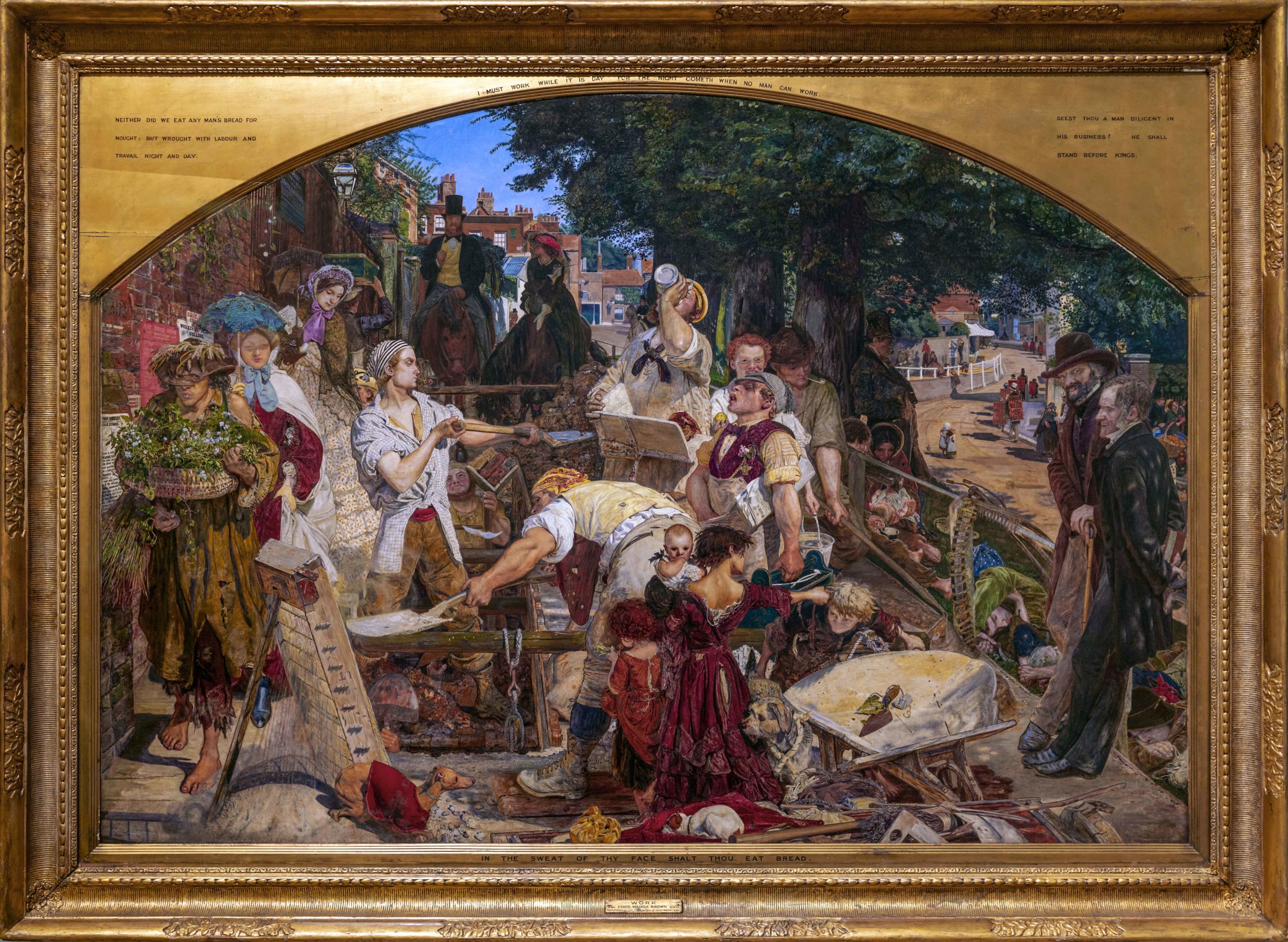The problem of labor, Ford Madox Brown’s Work, 1852–65, oil on canvas, 137 x 198 cm (Manchester Art Gallery) A conversation with Dr. Steven Zucker and Dr. Beth Harris
Victorian London
Construction projects have always been a part of city life, and Victorian London was no exception. Ford Madox Brown’s painting Work is a fascinating glimpse of just this. Our eye is immediately drawn to the young man in a striped hat effortlessly lifting a shovel high in the air, and the well-muscled forearms of the other workers.
Our eye then moves through the large canvas to the other figures, some more finely dressed and obviously of a different social class than the workers. But it is clear that Work is about more than just men digging. While the painting might appear to be a random view of a street, it is a carefully composed snapshot of the new way that different classes and professions encountered one another on the streets of Victorian London.
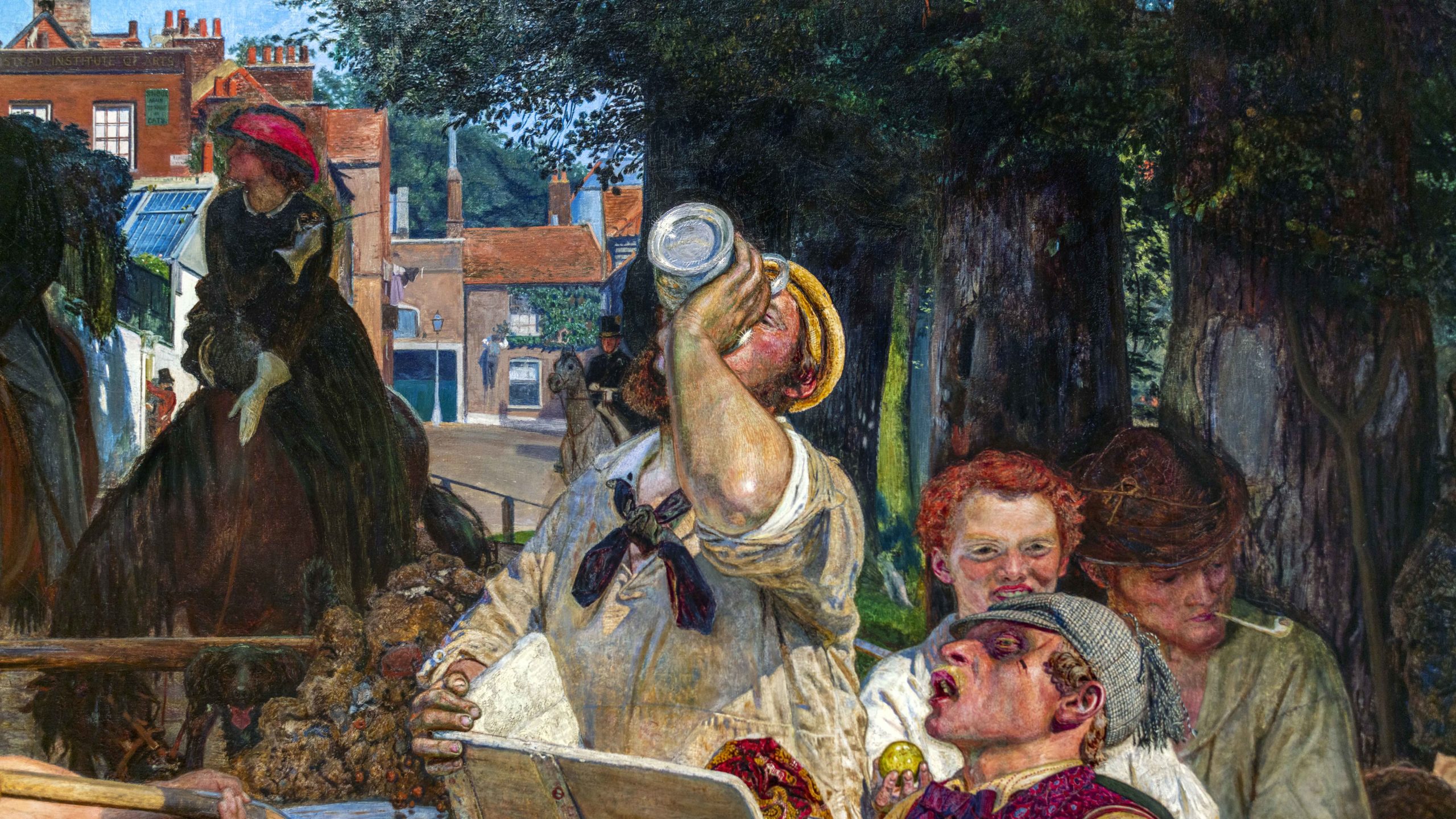
Drinking beer, (detail), Ford Madox Brown, Work, 1852-65, oil on canvas, 137 x 198 cm (Manchester Art Gallery)
Brown and the Pre-Raphaelites
Ford Madox Brown is associated with the Pre-Raphaelite Brotherhood, a group of British artists noted for their attention to detail, vibrant colors, and interest in scenes from literature. Although Brown himself was never an official member of the PRB, he was friendly with Dante Gabriel Rossetti and others in the group. The two got to know each other when Rossetti appeared on Brown’s doorstep in 1848 asking for art lessons. Although the lessons were short-lived, the two developed a lasting friendship. Through his association with the PRB, Brown adopted many of their stylistic tendencies, particularly the use of bright colors and attention to detail.
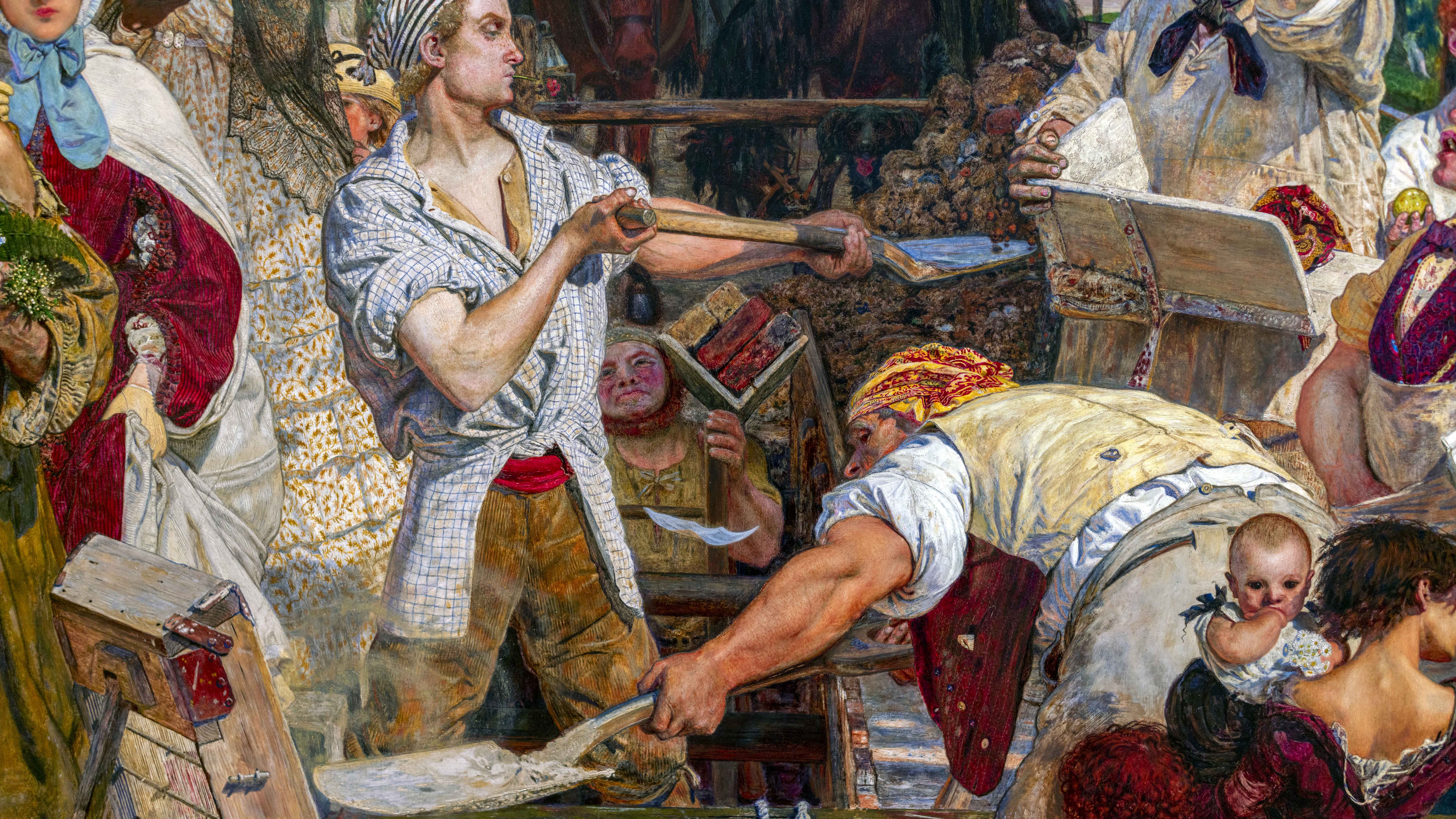
Navvies (detail), Ford Madox Brown, Work, 1852-65, oil on canvas, 137 x 198 cm (Manchester Art Gallery)
Modern life
However, Brown’s paintings show a much greater interest in subjects of modern life than many of the other artists associated with the PRB. Brown recalled that he got the idea for Work from seeing navvies, or construction workers, excavating sewers in Hampstead, North London. The painting was begun in the summer of 1852. Brown traveled to the same spot in Hampstead every day, transporting his canvas back and forth by means of a special cart. The background landscape of the painting was completed right on the street in Hampstead so that Brown could capture the precise details of light, color and form. This interest in direct observation and specificity were hallmarks of the Pre-Raphaelite style.
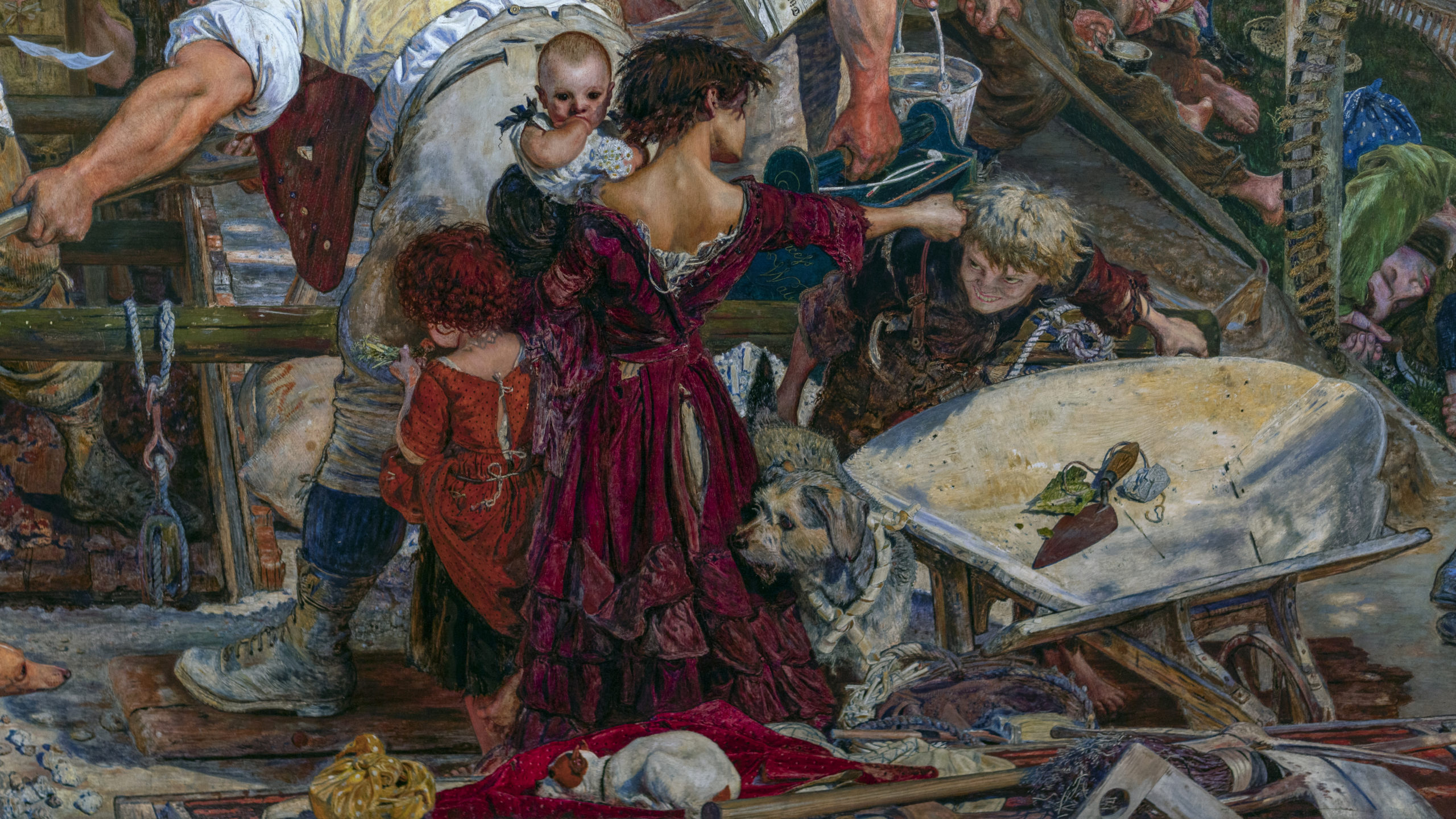
Children (detail), Ford Madox Brown, Work, 1852-65, oil on canvas, 137 x 198 cm (Manchester Art Gallery)
Victorian ideas of class
The painting centers on a group of working-class navvies. These figures represent the noble “working man,” as they are neatly dressed and diligently going about their tasks. In contrast to the workers, there is a group of ragged children in the foreground, representing the lowest of the lower classes. In the catalog of his 1865 one-man exhibition, Brown tells us that the children’s mother is dead, and that the oldest, a girl of ten, is in charge of the rest of the children. She wears a tattered dress and is holding an infant over one shoulder.
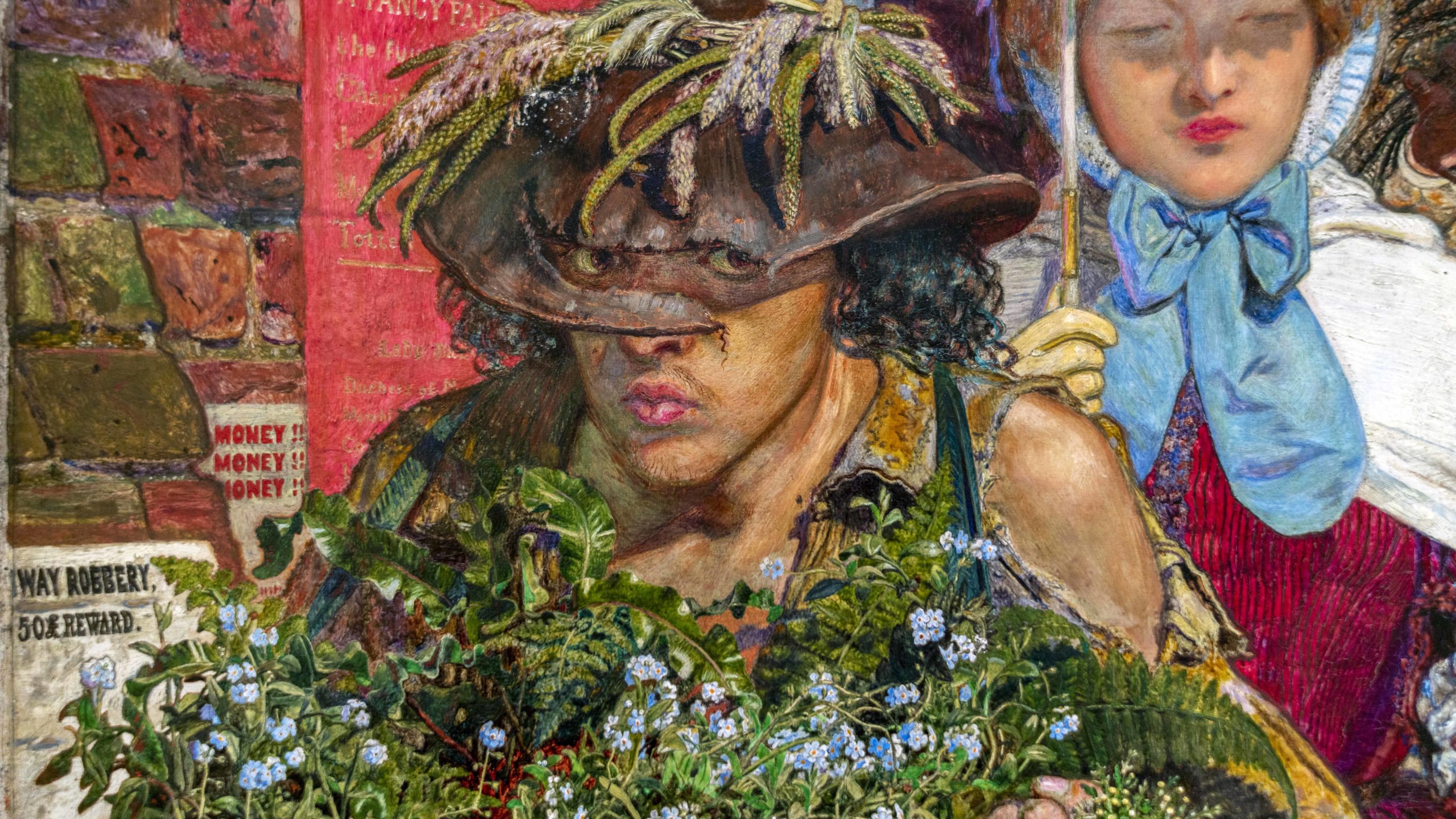
Herb seller (detail), Ford Madox Brown, Work, 1852-65, oil on canvas, 137 x 198 cm (Manchester Art Gallery)
Also representative of the lowest class is the ragged and barefoot plant seller on the left side, a figure whom Brown described as a “ragged wretch who has never been taught to work.” This hunched figure represents a stark contrast to the industrious and athletic navvies. shoveling away. Both the workers and the ragged children form another contrast, this time to the upper class figures depicted in the painting.
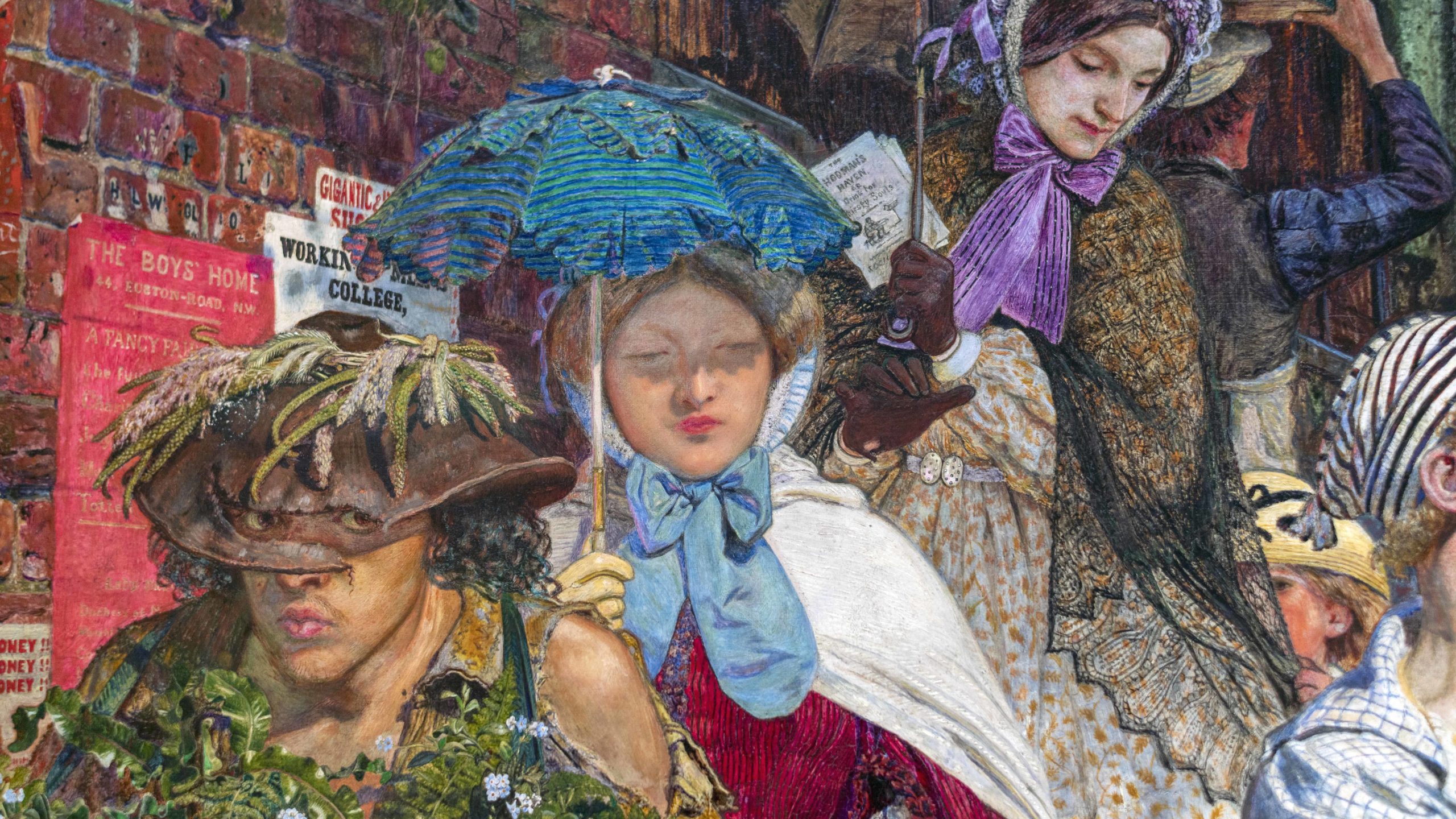
Navvies (detail), Ford Madox Brown, Work, 1852-65, oil on canvas, 137 x 198 cm (Manchester Art Gallery)
On the left hand side, two ladies skirt the edge of the picture. The first, lady carrying a parasol, is a portrait of the artist’s Brown’s wife Emma. Following along behind is another well-dressed woman who offers a religious tract to one of the navvies. Seeing to the religious education of the lower classes was a type of “work” engaged in by many evangelical middle-class women.
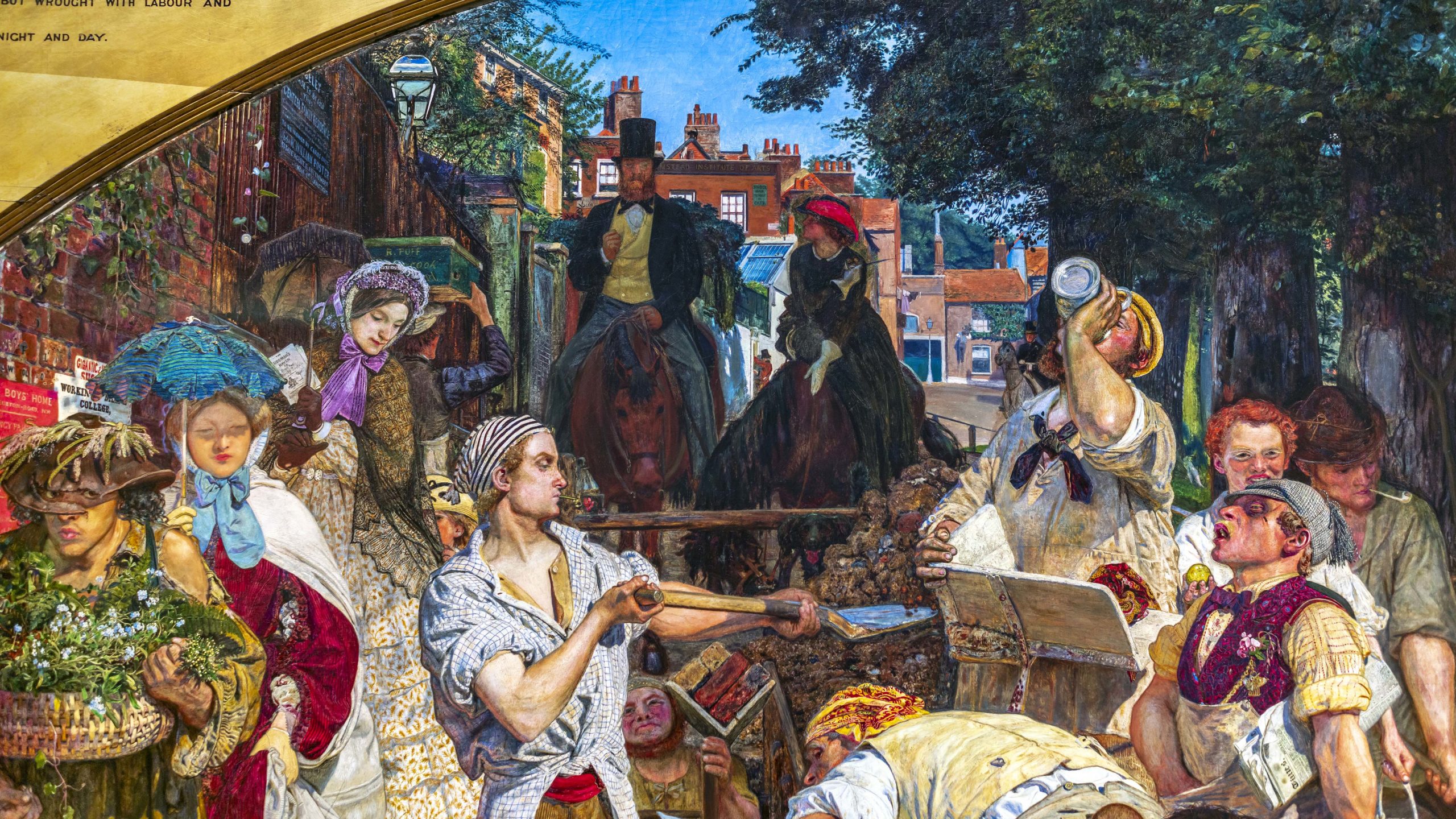
MP and daughter (detail), Ford Madox Brown, Work, 1852-65, oil on canvas, 137 x 198 cm (Manchester Art Gallery)
In the background we see two riders on horseback, illustrating the landed upper classes, who by virtue of their wealth and place in society, have no need to work. These class distinctions are even carried over into the pets in the foreground of the painting. The mongrel dog with a frayed rope collar stands with the group of children and stares at his more pampered counterpart, a small dog with a red coat.
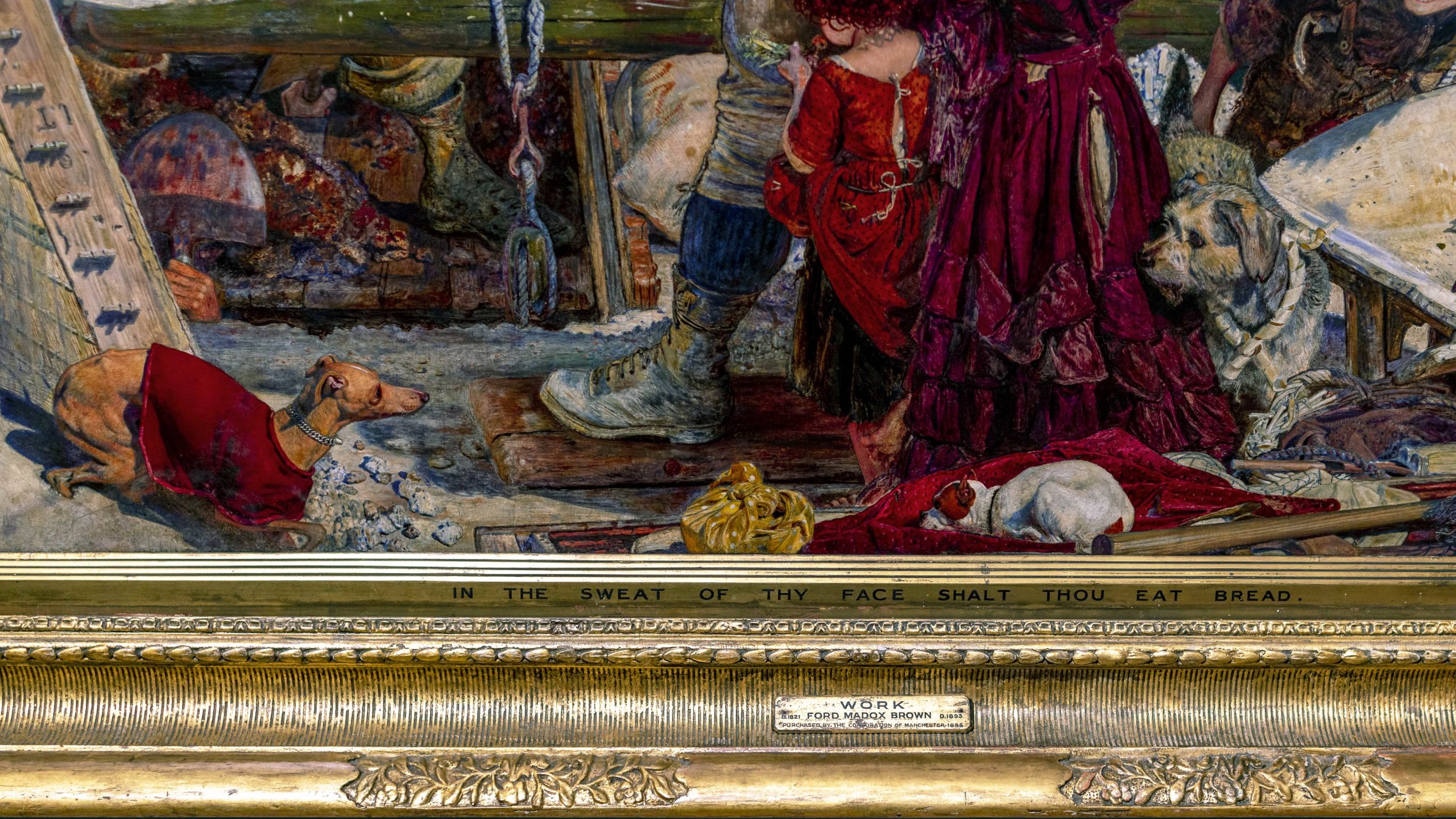
Dogs (detail), Ford Madox Brown, Work, 1852-65, oil on canvas, 137 x 198 cm (Manchester Art Gallery)
Maurice and Carlyle
On the right side of the painting, two well-dressed men watch the navvies work. These figures are portraits of two prominent men of the day, Frederick Denison Maurice and Thomas Carlyle, whom Brown dubbed “brainworkers.” Carlyle, the figure with the hat and stick, was the author of Past and Present, a book advocating social reform that Brown had read with interest. Maurice was a leading Christian Socialist and founder of the Working Men’s College, where Brown was recruited as an instructor along with Rossetti and the art critic John Ruskin. One of the posters visible on the far left side on the canvas is an advertisement for the Working Men’s College.
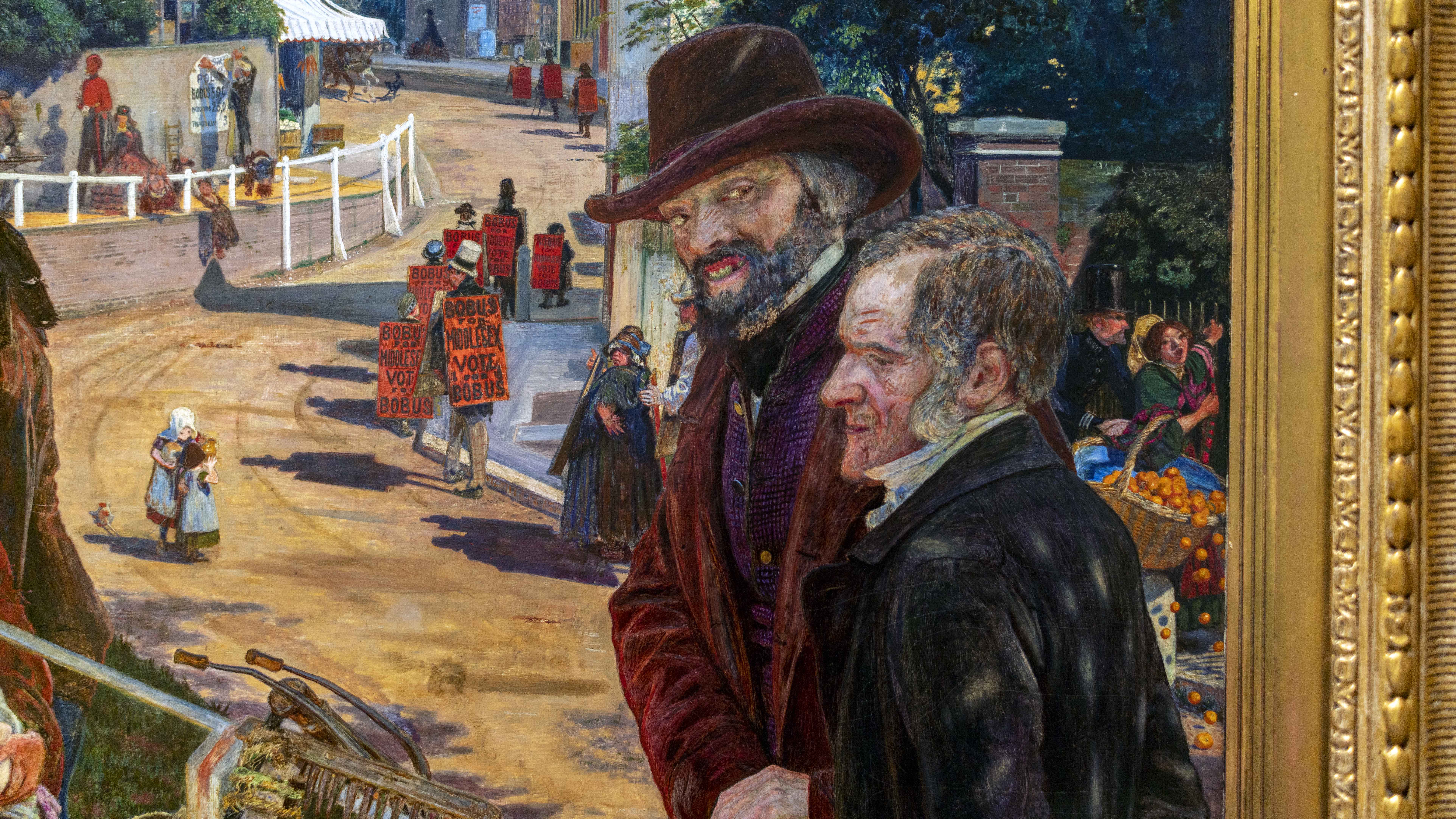
Frederick Denison Maurice and Thomas Carlyle (detail), Ford Madox Brown, Work, 1852-65, oil on canvas, 137 x 198 cm (Manchester Art Gallery)
At first glance Brown’s painting Work may appear to be an illustration of the stratification of social class in Victorian England. However, a deeper look reveals both a stunning example of the colorful and detailed Pre-Raphaelite style of painting as well as a commentary on the role of “work,” and its relationship to Victorian class structure. Work is at once a vivid reminder of both the class-consciousness of the Victorian age and the reforming spirit of that time which ultimately led to reforms like the ten-hour work day, and regulations restricting child labor.
Additional resources:
Video from Tate
Tim Barringer, Ford Madox Brown, Work
Tim Barringer, Men at Work: Art and Labour in Victorian Britain (Paul Mellon Centre, 2005).
Julian Treuherz, Kenneth Bendiner, and Angela Thirlwell, Ford Madox Brown: Pre-Raphaelite Pioneer (Philip Wilson Publishers, 2011).
John Albert Walker, Ford Madox Brown’s Painting and Victorian Life (Francis Boutle Publishers, 2006).
Smarthistory images for teaching and learning:
[flickr_tags user_id=”82032880@N00″ tags=”fmbwork,”]
[0:00] [music]
Dr. Beth Harris: [0:04] We’re in the Manchester City Art Gallery. We’re looking at one of the most famous paintings in their collection and one of the most famous paintings of the Victorian era, Ford Madox Brown’s painting, “Work.” It’s a painting that he worked on for more than a decade.
Dr. Steven Zucker: [0:21] There are so many figures in this painting. The three in the center really stand out: the man standing, heartily drinking his beer; below that, a man stooped, shoveling dirt; and just behind him, a man standing on a platform and adding dirt to a large pile.
[0:38] They are navvies, excavators. We think that they’re digging a trench for a new water line, but they are heroicized, they are ennobled.
Dr. Harris: [0:47] He’s comparing the heroism of their labor with other kinds of labor. We have a father and a daughter, members of the upper classes, the man likely a Member of Parliament; below that, a woman distributing leaflets about her charity work on behalf of the working classes.
[1:06] In front of that figure, we see a woman carrying a parasol, beautifully dressed, who doesn’t seem to be engaged in work at all.
[1:14] In front of that, a really interesting and problematic figure who’s clearly impoverished, selling weeds, flowers, a male figure who’s clearly set off in what Brown calls his “effeminacy” against the male heroism of the central navvies. Brown describes this figure as someone who has not been taught the value of work.
Dr. Zucker: [1:40] Mirroring this arc of figures stacked on the left is another gentle arc on the right. Here we see a variety of workers, including a beer seller. This arc leads our eye down to a group of children.
[1:51] In the center, we see a young girl. She’s wearing a dress that’s much too large for her, and she’s holding a child who’s got a little black ribbon, which signifies that their mother has died. And so this young girl has taken on this maternal responsibility. With her left hand holding a child, but with her right, she’s disciplining her brother.
Dr. Harris: [2:12] On the other side of her is a young girl that she’s also in charge of, who’s eating the end of a carrot.
Dr. Zucker: [2:18] The vast majority of the painting is given over to this contrast of different elements of society and the heroism of labor. But there’s a different kind of labor that’s exhibited by the two men who stand in shadow and look upon this scene very much the way that we do.
Dr. Harris: [2:33] These are two men who theorized about labor, about work: on the left, Thomas Carlyle, and on the right, you see F.D. Maurice. Both of these men approached the problems of the working classes during this period in different ways.
[2:51] It’s really interesting to me that this is a painting called “Work.” But the workers who were probably most on everyone’s mind are not included here. We don’t see industrial labor. We don’t see factory labor. We don’t see the work of tailors and other artisans who were being put out of work. We’re looking at a moment in history of the emergence of a working class, and a working class that feels its political power.
[3:20] But this is a painting that heroizes manual labor here. Not agricultural labor, which would be the more traditional kind of work, but manual labor in the city.
Dr. Zucker: [3:31] The artist does make room in this painting for agricultural workers who have lost their livelihood. We can identify them by the agricultural implements that surround them. There’s also a family group. We see a mother feeding her child. We see a man. We know that they are poor and displaced.
Dr. Harris: [3:48] This is, in a way, the most sympathetic part of the painting. Brown is showing us how this family is neglected and impoverished in the modern city. I think it points to a central paradox that was keenly felt during this time, which was that England was a place of tremendous wealth. It had propelled the Industrial Revolution. But at the same time, it had impoverished so many.
[4:15] That conflict was referred to as the Condition-of-England problem. Carlyle, one of the brain workers that we see on the right, wrote, “The condition of England is justly regarded as one of the most ominous, and withal one of the strangest, ever seen in this world. England is full of wealth, supply for human want in every kind, yet England is dying.”
[4:41] There were so many people at this moment looking for a solution, not least of which because the working classes were feeling their power. The Chartists were presenting petitions to Parliament demanding suffrage, demanding the right to vote for men.
Dr. Zucker: [4:57] The vote was critical because labor reforms, for one, were so badly needed.
Dr. Harris: [5:02] Brown is asking, “Who is going to fix this problem? Is it the Member of Parliament? Is it the woman who’s handing out leaflets? Is it the thinkers on the right?”
Dr. Zucker: [5:11] It’s certainly not the political campaigning that we see in a little vignette in the extreme right. The artist seems to be saying that honest work outside in the sunlight is what will save England.
Dr. Harris: [5:23] We have biblical quotes on the frame that reinforce that idea. But I also think it’s important to step back and note the incredible modernity of what we’re looking at, the city street where the artist is capturing the effect of sunlight.
Dr. Zucker: [5:39] He painted it largely on location in Hampstead, London.
Dr. Harris: [5:43] The idea of truth to nature.
Dr. Zucker: [5:46] This is such a modern scene. We have the sense of the bustle of the city, of people moving past each other, of glimpses of figures, of fragments of figures. This is the complexity of urban experience, and it has a moral underpinning. He’s asking bigger questions.
[5:59] [music]

